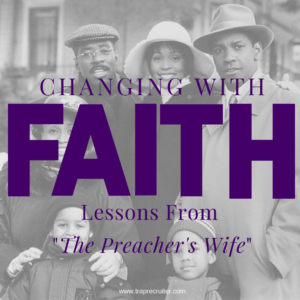
Faith can move mountains
Darling, you will see
I can move mountains
If you have faith in me
(Raleigh, B. & Wood, G, 1952)
The Preacher’s Wife is one of my favorite Christmas movies. Like many in the genre it’s filled with music, merriment, and miracles. It is the story of a Baptist church, its pastor, the pastor’s wife, and an angel who has come at a time when financial problems, declining membership, and a disengaged leader have the desperate for change.
In any change process, there are a number of stakeholders who are affected.
Rev. Biggs: The recently appointed Pastor has the legacy of the beloved, deceased Pastor with whom he has to contend. He shows no leadership commitment to the change process, lets the past be a hindrance, and is rapidly losing faith.
Dudley: An angel who comes to help the Pastor and ultimately the church population through the change process. In an organization, he would be an outside consultant who can offer guidance and impartial feedback and solutions because he is not emotionally connected.
Julia Biggs: She is the preacher’s wife and most energized change agent. In terms of an organization, I see her as the HR Leader. Julia takes on the task of working with the consultant and inadvertently assumes the responsibility of leading the organization through the change process. She knows that her commitment is first and foremost to the organization, but finds herself in a difficult situation when the leader will not step up to the plate.
Jeremiah Biggs: The son of Henry and Julia. He develops a relationship with Dudley and has no choice but to trust in his vision because his father is absent. He represents the employees who are open to change because they believe anything is better than the current state.
Joe Hamilton: A Real Estate developer who appears to be the answer to the church’s financial problems. He offers to buy the church but intends to tear it down to build condominiums. In exchange, he will build a new church in a remote location. This proposition is detrimental because, among other things, it is not a cultural fit for the organization.
Margeritte Coleman: Rev. Biggs mother-in-law and the former First Lady. She represents the employees who are most resistant to change simply because they are married to the past. They reject anything that threatens the way things used to be.
Beverly: Rev. Biggs skeptical assistant. She represents the employees who are resistant to change because they don’t know how they will fit into the organization once the process is complete.
As the Leader of the organization, Rev. Biggs is ultimately responsible for guiding and managing the change process. Unfortunately, he finds himself in a situation where he is lacking FAITH.
Future State: A leader should be able to clearly articulate his/her vision for the organization once the change process is complete.
Alleviate Fear: Communicate early and often, provide answers to tough questions, and dispel rumors.
Implementation Plan: An effective change process requires a detailed plan that outlines the course of action, strategy, schedule, cost, and anticipates roadblocks and how to overcome them.
Timing: Allot for time to achieve set milestones.
Healthy and happy environment: The desired end result.
Knowing that change is constant, I’ve never understood how or why many organizations manage it so poorly. Like Rev. Biggs, perhaps the principals in the organization are not properly influencing and leading the change process. Maybe there is more focus and energy spent emphasizing the barriers to the proposed change. Or, there could be a Joe Hamilton, an external force, who tries to exploit the diminished integrity of the process for his own benefit. In any and all instances when the change process is compromised, activate your F.A.I.T.H, to get back on track.